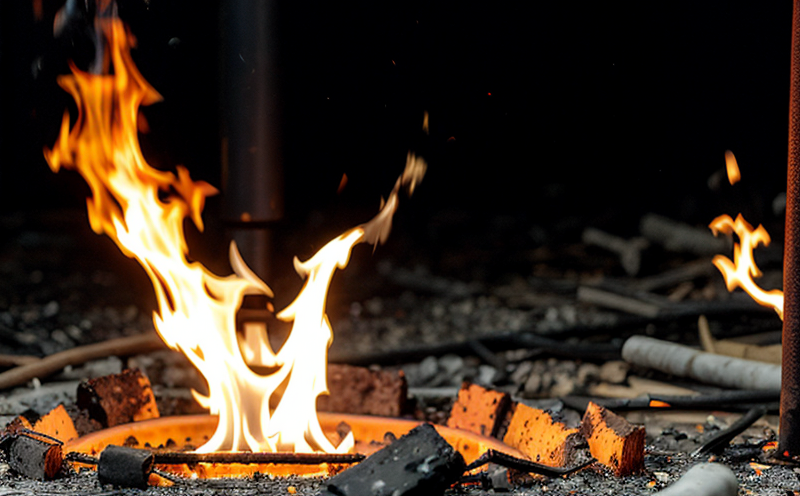EN 71-2 Cellulosic and Fabric Toys Flammability Test
The European Standard EN 71-2 specifies requirements for flammability of toys made from cellulosic materials, such as paper, cardboard, wood, and fabrics. This test is critical to ensure the safety of children by preventing burns or other injuries caused by ignition of these materials under normal use conditions.
The standard aims to protect consumers by providing a robust framework for evaluating how quickly and intensely materials will burn when exposed to sources of heat, flame, or sparks. It applies not only to toys but also to related products like play equipment, clothing, and accessories that come into contact with children during playtime.
Flammability testing is one of the most important aspects of toy safety because fabric and cellulosic materials are common in many children's products. These materials can easily ignite when exposed to sources of heat or flame, posing a serious risk if not properly managed. The test helps identify potentially hazardous items early on, allowing manufacturers to modify their designs or formulations before they reach the market.
The EN 71-2 standard outlines detailed procedures for conducting flammability tests using both open-flame and hot-air methods. The objective is to simulate real-world scenarios where a child might come into contact with an ignition source while playing. This includes placing the toy in various positions, such as standing up or lying down, to account for different angles of exposure.
For cellulosic materials, the test involves exposing specimens to a specified flame and measuring the time it takes for them to ignite, burn, and extinguish. The duration is compared against predetermined thresholds defined by international standards like ISO 13943-5. If the material fails to meet these criteria, further analysis may be required to determine its flammability characteristics.
Similarly, fabric toys undergo similar testing but with additional considerations for their unique properties. Fabric can vary significantly in terms of composition and texture, which affects how it responds to heat sources. Therefore, special attention must be paid during specimen preparation and test execution to ensure accurate results.
The importance of this test cannot be overstated; it plays a crucial role in safeguarding children's health and well-being by reducing the likelihood of accidental injuries due to flammable materials. By adhering strictly to EN 71-2, manufacturers demonstrate their commitment to producing safe toys that comply with global safety regulations.
In summary, EN 71-2 provides a comprehensive approach to assessing the flammability risks associated with cellulosic and fabric toys. Through rigorous testing methods, it ensures that these materials do not pose undue hazards when used by children in their daily play activities.
Applied Standards
The primary standard for this service is EN 71-2:2019 Toy Safety – Part 2: Flammability of Toys Made from Cellulosic Materials and Fabric. This edition was published by the European Committee for Standardization (CEN) in September 2019, replacing earlier versions issued in 2014 and 2009.
EN 71-2 specifies requirements for the flammability of toys made from cellulosic materials such as paper, cardboard, wood, cotton fabric, etc., while also covering those with fabric components. The standard covers both open-flame tests (using a gas flame) and hot-air tests (employing a forced air system).
It defines key parameters like the maximum length of flaming time allowed for each type of material under different test conditions. Compliance with these limits ensures that toys do not present an unacceptable risk of catching fire during normal play scenarios.
Benefits
Compliance with EN 71-2 offers numerous benefits to toy manufacturers, retailers, and distributors:
- Enhanced Reputation: Demonstrating adherence to stringent safety standards enhances brand reputation among consumers.
- Increased Sales: Safe products are more likely to gain consumer trust leading to higher sales volumes.
- Reduced Liability Risks: By ensuring product safety, companies minimize potential legal action from injuries resulting from non-compliant items.
- Globally Recognized: Meeting European standards makes it easier for businesses to export their products internationally without additional certification requirements in other countries that have adopted similar regulations.
- Improved Consumer Confidence: Parents are reassured knowing that they can purchase toys confidently, reducing anxiety about product safety issues.
- Cost Efficiency: Early identification of potential hazards through rigorous testing helps avoid costly recalls later on.
- Regulatory Compliance: Staying ahead of regulatory changes ensures continuous compliance and avoids penalties for non-compliance.
In addition to these direct benefits, companies that comply with EN 71-2 also contribute positively towards public health by preventing accidents involving children who might come into contact with potentially dangerous materials. This proactive approach aligns well with modern corporate social responsibility initiatives aimed at improving overall safety standards within the industry.
Competitive Advantage and Market Impact
In today’s competitive toy market, meeting stringent safety requirements like those outlined in EN 71-2 can give manufacturers a significant edge over competitors who fail to meet these benchmarks. Here are several ways compliance contributes to a company's competitive positioning:
- Differentiation from Competitors: Adhering strictly to global standards sets your brand apart as a leader committed to excellence in product safety.
- Better Market Access: Many international markets require proof of compliance with specific safety standards. Compliance with EN 71-2 opens doors to these lucrative export opportunities.
- Innovation Opportunities: Working towards meeting strict standards encourages continuous improvement, fostering innovation in safer product design and materials selection.
- Customer Trust: Parents and guardians place great importance on toy safety. Demonstrating compliance builds trust with your target audience, encouraging repeat purchases and word-of-mouth recommendations.
- Longevity of Brand: A reputation for high-quality, safe toys helps establish long-term relationships with consumers, contributing to brand loyalty and longevity.
- Avoidance of Negative PR: Non-compliance can lead to negative publicity and loss of consumer confidence. Meeting standards proactively avoids such pitfalls.
The impact extends beyond individual companies; it also influences broader market trends towards safer, more responsible toy production practices. By leading the charge in adopting stringent safety measures, industry leaders set new benchmarks that other players must follow to maintain relevance and competitiveness.





